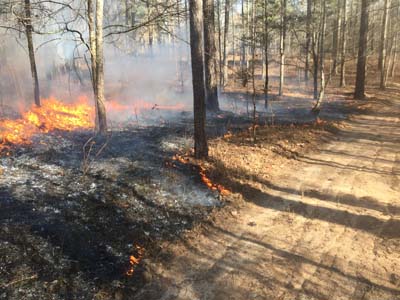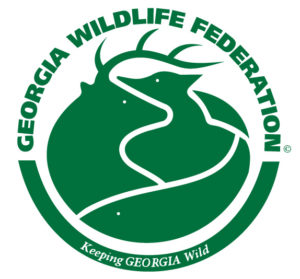For more information, contact Mike Worley at (770) 787-7887.
FOR IMMEDIATE RELEASE
Covington, GA (Nov. 16, 2016) — Most of Georgia is facing extreme hazards from wildfire. Many of us recognize the beneficial effect fire can have on wildlife and wildlife habitat under the proper conditions. Wildfire, on the other hand, when conditions are so very dry, can be quite another story. Wildfire can obviously cause damage to property, health, and life. It can also wreak havoc with wildlife and wildlands management plans that many private landowners pursue on their property.
The information below, outlined by Tiffany Woods, Senior Forestry Coordinator at National Wildlife Federation, is a straightforward description of some steps that landowners can take to help mitigate the threats of catastrophic damage from wildfire.
 Manual Fire Breaks
Manual Fire Breaks
Manual firebreaks can be created by exposing strips of bare soil or fire impeding vegetation meant to stop or control fire. Creating firebreaks around the perimeter of your land and forested acres can minimize the threat of ground fires entering your property. You can also create interior firebreaks around certain areas, such as a hardwood stand or around a building structure, to minimize risks to this area. Breaks should greater than 10 feet wide or twice the estimated flame length. You will first want to clear the planned firebreak strip by using equipment and blading, disking or plowing the break. If these tools are unavailable, you can manually mow and rake the area down to bare soil as an alternative. Firebreaks are especially important for land with topographic changes, as wildfires burn up a slope faster and more intensely than on flat ground. A steeper slope will result in a faster moving fire with longer flame lengths – firebreaks should be installed accordingly. Due to the steady falling of leaves, fire breaks should be inspected and raked regularly to prevent leaf accumulation.
Reduce Sources of Fuel
Remove as much dead brush and fuel sources from your forests and thin trees if possible. This can be done in the near term and regularly included in future land management. Remove tree branches that are closer to the ground to prevent ground fires from climbing into the canopy, resulting in crown fires. Reduce excess fuel near fire breaks to reduce flame length and potential of fire crossing the break.
Protect Structures and Equipment
Fire officials recommend reducing and managing the area around your house or other building structures for at least 100 feet. Move and isolate any farm equipment and vehicles to safe locations, especially equipment with fuel tanks and highly flammable materials and accelerants.
Additionally, have the equipment (hand tools and/or machinery) used to create and maintain your fire breaks serviced, ready for use, and easily accessible.
 Implement Control Burns in the Future
Implement Control Burns in the Future
Until burn bans throughout much of the state are lifted and rain returns to the region, controlled burning (also called prescribed fire) is NOT an option. However, in the future when weather conditions provide a wetter season, control burns are an economical, effective management tool to reduce fuel loads on the forest floor.
If faced with a wildfire, DO NOT attempt to fight the wildfire on your own unless you are a trained wildland firefighter with proper Personal Protective Equipment (PPE). In Georgia please call the Georgia Forestry Commission at 478-751-3500 or 911 to report a wildfire.
Tiffany Woods, Sr. Forestry Coordinator at National Wildlife Federation with contributions by Drew Arnold, Claude Jenkins, and Kyle Marable, Resource Stewardship Biologists at Alabama Wildlife Federation. Photos of fire break and prescribed fire in Oconee County, GA courtesy of Tiffany Woods.
###
